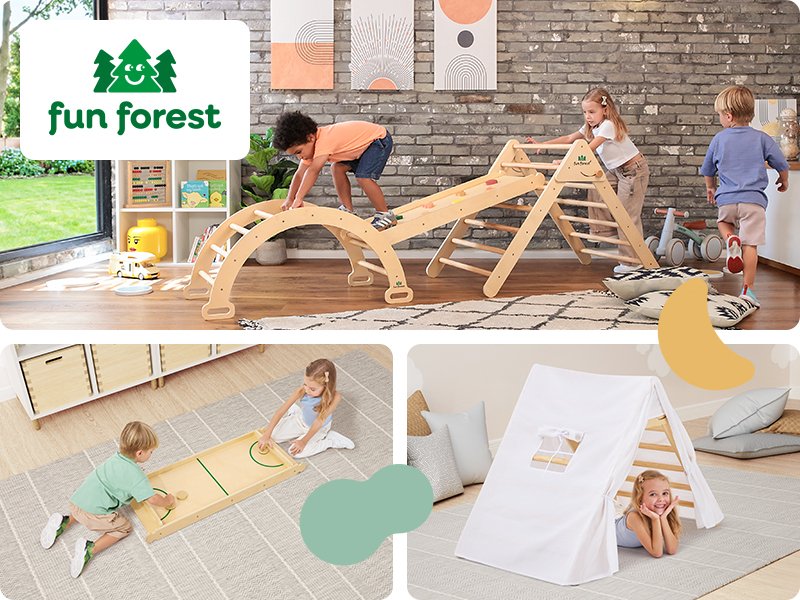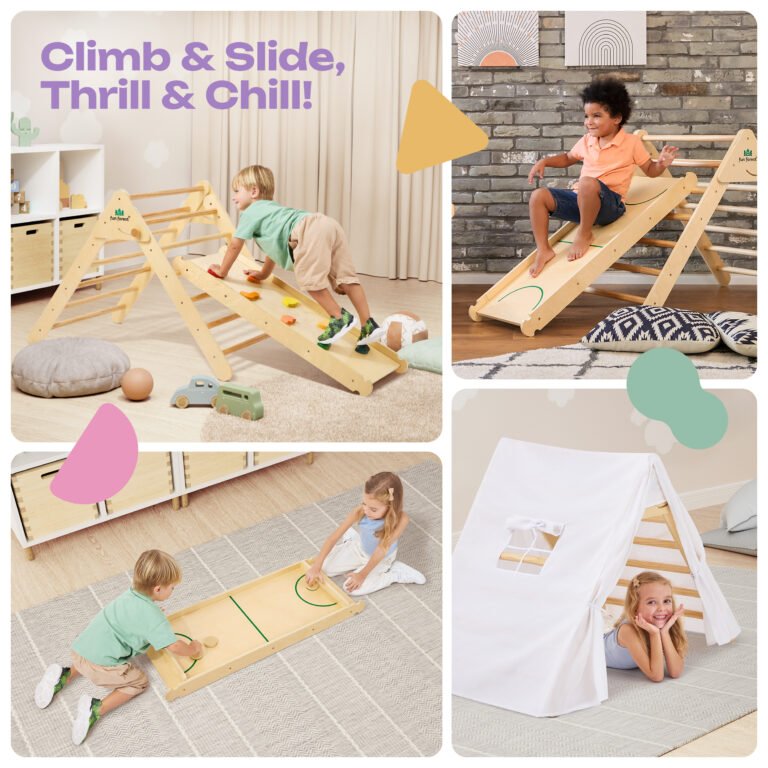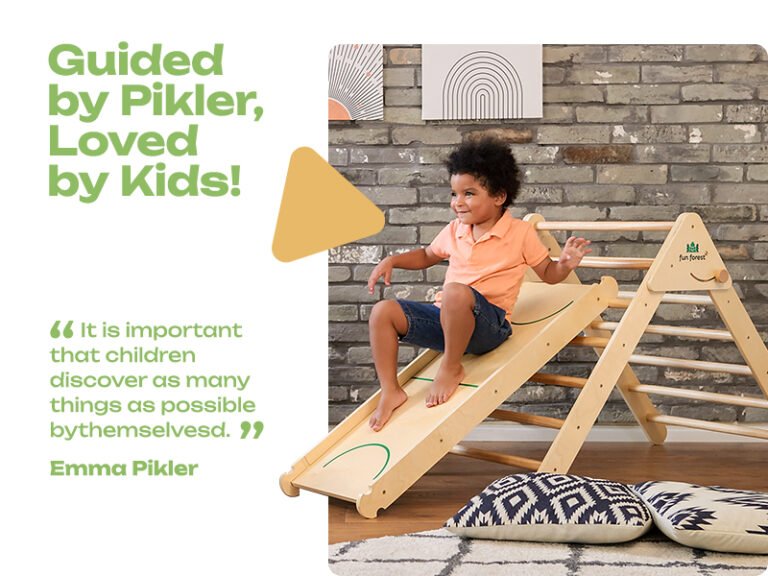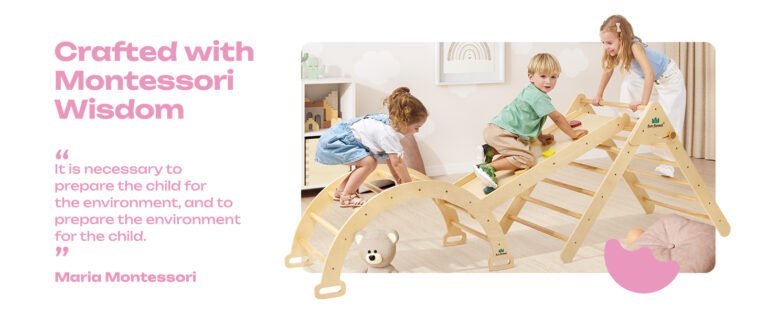The Fascinating History of the Pikler Triangle: From Revolutionary Pediatric Care to Modern Fun Forest Adventures
Every parent watching their child confidently climb a Pikler triangle today is witnessing the legacy of a remarkable woman whose revolutionary ideas about child development changed how we understand childhood itself. The story of the Pikler triangle isn’t just about a piece of climbing equipment—it’s about a pediatrician’s passionate belief that children possess an innate wisdom about what they need to thrive.
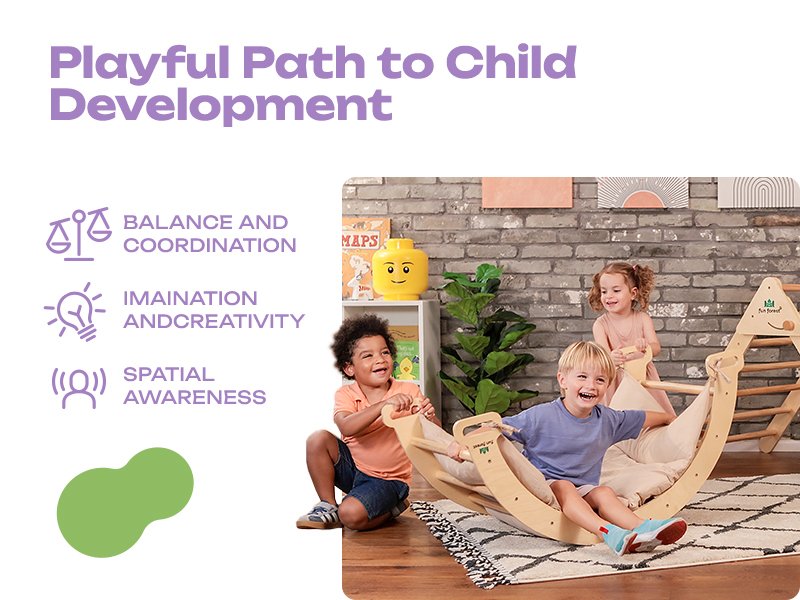
The Visionary Behind the Triangle: Dr. Emmi Pikler
Born in Vienna in 1902, Dr. Emmi Pikler was destined to revolutionize our understanding of early childhood development. After completing her medical studies and specializing in pediatrics, Dr. Pikler began questioning the conventional wisdom of her time—particularly the belief that children needed constant adult intervention and protection to develop properly.
Working as a family pediatrician in Budapest during the 1930s, Dr. Pikler made observations that would eventually transform how we think about children’s natural development. She noticed that children who were allowed to move freely and explore their environment at their own pace developed better motor skills, more confidence, and stronger problem-solving abilities than those who were constantly directed and restricted by adults.
A Revolutionary Approach Born from Tragedy
Dr. Pikler’s theories were put to the ultimate test when she was appointed director of the Lóczy Institute, a residential nursery for orphaned and abandoned children in post-war Budapest. This wasn’t just a professional opportunity—it was a chance to prove that her revolutionary approach to child-rearing could work even under the most challenging circumstances.
At Lóczy, Dr. Pikler created an environment where children were treated with profound respect and given unprecedented freedom to develop according to their own internal timeline. The results were extraordinary: children who had experienced early trauma and loss flourished in ways that defied conventional expectations about institutional care.
The Birth of the Pikler Triangle
It was within this context of respectful, observation-based childcare that the Pikler triangle was born. Dr. Pikler noticed that children had an irrepressible urge to climb, explore vertical space, and challenge themselves physically. Rather than seeing this as problematic behavior to be controlled, she recognized it as a fundamental developmental need.
The Science Behind the Design
Dr. Pikler’s triangle wasn’t created randomly—every aspect was carefully considered based on her observations of children’s natural development:
🔺 The Triangular Shape: Provides stability while allowing multiple approach angles
📏 The Rung Spacing: Perfectly sized for small hands and developing grip strength
📐 The Angle: Challenging enough to be engaging, gentle enough to be safe
🪵 The Materials: Natural wood that appeals to children’s senses
Core Principles That Shaped the Design
Dr. Pikler’s triangle embodied three revolutionary principles that went against the childcare wisdom of her era:
1. Respect for the Child’s Natural Development
Dr. Pikler believed that children possessed an innate knowledge of what their bodies needed for healthy development. The triangle allowed children to follow their internal developmental drives without adult interference.
2. Freedom of Movement as Essential
Long before modern research confirmed the connection between movement and brain development, Dr. Pikler understood that physical freedom was crucial for cognitive, emotional, and social growth.
3. Trust in Children’s Competence
Perhaps most radically, Dr. Pikler trusted that children could assess their own abilities and make safe choices about physical challenges when given appropriate environments.
The Lóczy Legacy: Proving the Power of Respect
The children at the Lóczy Institute became living proof of Dr. Pikler’s theories. Researchers from around the world came to observe and were amazed by what they found:
- Superior Motor Development: Children moved with exceptional grace and confidence
- Emotional Resilience: Despite their difficult beginnings, the children showed remarkable emotional stability
- Independence: Children displayed self-reliance and competence far beyond their years
- Social Skills: The respectful environment fostered cooperation and empathy
The Triangle’s Role in This Success
The Pikler triangle played a crucial role in these outcomes. It provided:
- Safe Challenge: Children could test their limits without dangerous consequences
- Self-Paced Learning: No two children used the triangle the same way or timeline
- Confidence Building: Success came from genuine achievement, not adult praise
- Body Awareness: Children developed sophisticated understanding of their physical capabilities
From Institution to International Movement
Word of Dr. Pikler’s remarkable work began to spread beyond Hungary. The triangle that had been born in a post-war orphanage started appearing in progressive nurseries and homes around the world. Parents and educators who embraced child-led development found in the Pikler triangle a perfect tool for honoring children’s natural growth patterns.
The Connection to Montessori Education
Although Dr. Pikler and Maria Montessori never worked together, their philosophies aligned beautifully. Both were physicians who:
- Believed in the competence of children
- Emphasized freedom of movement
- Trusted in natural development patterns
- Created environments that supported rather than directed learning
This philosophical alignment explains why Pikler triangles became beloved fixtures in Montessori homes and schools worldwide.
Modern Evolution: From Clinical Tool to Family Treasure
Today’s Pikler triangles honor Dr. Pikler’s original vision while adapting to modern family life. The core principles remain unchanged, but contemporary designs address the practical needs of today’s families.
The Fun Forest Evolution
Modern interpretations like the Fun Forest Pikler collection capture the essence of Dr. Pikler’s original vision while bringing natural beauty and family-friendly features to contemporary homes:
🌲 Natural Aesthetics: Beautiful wood finishes that complement modern home decor
📦 Practical Features: Foldable designs for real-world living spaces
🛡️ Safety Standards: Meeting today’s rigorous safety requirements while maintaining developmental benefits
👨👩👧👦 Family-Focused: Designed for multi-child households and varying developmental stages
Why Dr. Pikler’s Vision Matters More Than Ever
In our digital age, Dr. Pikler’s insights about the importance of physical movement and self-directed exploration are more relevant than ever. Research continues to validate her observations:
Modern Research Confirms Pikler’s Insights
- Neuroscience: Movement directly supports brain development and learning
- Psychology: Self-directed challenge builds genuine confidence and resilience
- Motor Development: Free movement creates more competent, coordinated children
- Emotional Health: Physical competence supports emotional regulation and well-being
Addressing Today’s Childhood Challenges
Dr. Pikler’s triangle addresses many concerns facing modern families:
- Screen Time: Provides engaging alternative to digital entertainment
- Sedentary Lifestyles: Encourages natural, joyful movement
- Anxiety: Builds confidence through manageable challenges
- Attention Issues: Develops focus through engaging physical activity
The Enduring Legacy in Every Climb
When you watch your child navigate their Pikler triangle today, you’re witnessing the continuation of Dr. Pikler’s revolutionary legacy. Every confident step, every thoughtful pause to assess the next move, every proud smile at the top—these moments embody her belief that children are competent, capable beings worthy of our trust and respect.
Choosing a Triangle That Honors This Legacy
For families ready to bring this remarkable legacy into their homes, the Fun Forest collection offers triangles that honor Dr. Pikler’s vision while meeting modern family needs:
🌟 Fun Forest Pikler Triangle – Experience the perfect balance of Dr. Pikler’s developmental wisdom and contemporary family-friendly design. This beautiful triangle brings the forest’s natural tranquility into your home while supporting your child’s journey toward confidence and competence.
🎯 Complete Fun Forest Pikler Set – Expand the possibilities with accessories that extend Dr. Pikler’s philosophy of respectful, child-led development. Create an environment where your child can explore, challenge themselves, and grow according to their own inner wisdom.
From War-Torn Budapest to Your Living Room
The journey from Dr. Pikler’s innovative orphanage to today’s Fun Forest triangles spans nearly a century, but the core message remains unchanged: children are competent, capable beings who deserve our respect and trust. The triangle that began as a clinical tool for supporting traumatized children has evolved into a beloved fixture in homes around the world.
The Philosophy Lives On
Every modern Pikler triangle carries forward Dr. Pikler’s fundamental beliefs:
- Children know what they need: Trust your child’s developmental instincts
- Movement is medicine: Physical freedom supports all areas of development
- Respect transforms relationships: Treating children as competent creates competence
- Simple is profound: The most effective tools often have the simplest designs
A Tool for Modern Families, Rooted in Timeless Wisdom
Dr. Emmi Pikler could never have imagined that her simple wooden triangle would become a global symbol of respectful child-rearing. Yet her vision of honoring children’s natural development patterns resonates more strongly today than ever before.
In a world that often rushes children through developmental stages or over-protects them from natural challenges, the Pikler triangle stands as a gentle reminder of what children truly need: respect, trust, and the freedom to become who they’re meant to be.
Your Family’s Chapter in This Story
When you bring a Pikler triangle into your home, you’re not just purchasing play equipment—you’re joining a nearly century-long tradition of families who believe in honoring children’s natural development. You’re choosing to trust your child’s innate wisdom about what they need to grow strong, confident, and capable.
The Fun Forest Pikler Triangle represents the latest chapter in this remarkable story—one that began with a dedicated pediatrician’s observations and continues today in living rooms around the world where children climb, explore, and discover their own capabilities.
Honoring the Past, Embracing the Future
Dr. Emmi Pikler passed away in 1984, but her legacy lives on in every child who experiences the joy of conquering their own personal summit. Her revolutionary understanding that children are naturally competent continues to challenge and inspire parents, educators, and child development professionals worldwide.
The Pikler triangle stands as perhaps her most enduring contribution—a simple yet profound tool that embodies respect for children and trust in their natural development. From the war-torn orphanage in Budapest to the modern homes where Fun Forest triangles create daily adventures, the message remains clear: when we honor children’s natural development, extraordinary things happen.
Ready to become part of this remarkable legacy? Bring the wisdom of Dr. Pikler’s vision into your home with a Fun Forest Pikler Triangle and watch as your child discovers their own natural competence and joy in movement.
The history continues with every climb, every challenge overcome, and every confident child who knows they can trust their own abilities. Your family’s story in this remarkable tradition begins now.

